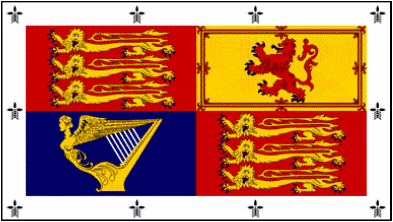 Standard for Other Members of the Royal Family
Standard for Other Members of the Royal Family
without a Personal StandardOther Members of the Royal Family
In 1917 the escutcheon of Saxony was removed from the Standard used by membr of the Royal Family who did not have a personal version of the Royal Standard.
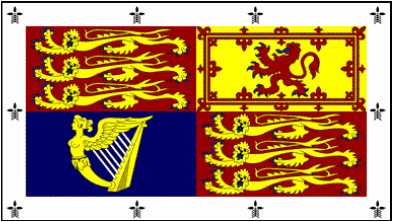 Standard for Other Members of the Royal Family after 1957
Standard for Other Members of the Royal Family after 1957
without a Personal Standard There may have been versions made between 1937 and 1957, in which red was replaced by crimson, and at some time after 1957 this Standard was produced with the revised Royal Standard of that year.
 Standard of Albert, Duke of York
Standard of Albert, Duke of York
[Royal Standard differenced by three point label charged with one blue anchor]Albert, Duke of York 1920 - 1936
Albert, the Duke of York, (full name Albert Frederick Arthur George) was the second son of King George V. He became King George VI in December 1936, but had never been Prince of Wales, as that title had been held by his elder brother Edward, who abdicated shortly after becoming King Edward VIII.
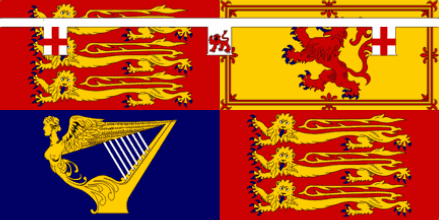 Standard of Henry, Duke of Gloucester
Standard of Henry, Duke of Gloucester
[Royal Standard differenced by three point label charged with one red lion, passant guardant, and two crosses of St. George]Henry, Duke of Gloucester 1934 - 1974
Henry, the Duke of Gloucester, was the third son of King George V. His Standard was the second new Personal Standard introduced during the reign of King George V. [ADM 1/8774/111]
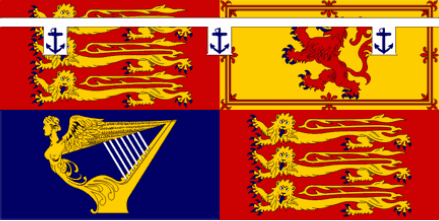 Standard of George, Duke of Kent
Standard of George, Duke of Kent
[Royal Standard differenced by three point label charged with three blue anchors]George, Duke of Kent 1934 - 1942
George, the Duke of Kent, was the fourth son of King George V. His Standard was the third new Personal Royal Standard introduced during the reign of King George V. [ADM 1/8774/111]
 Standard of Queen Elizabeth
Standard of Queen Elizabeth
[Royal Standard and Bowes-Lyon Standard impaled. The latter is Scotland, blue on white,
in the first and fourth quarters, and three long-bows proper on an ermine field in the second and third]Queen Elizabeth 1937 - 2002
When Albert, Duke of York, became King George VI, his wife, Lady Elizabeth Bowes-Lyon, became Queen Elizabeth. She was granted a Standard in which the Royal Standard and her personal Standard were impaled. Illustrations of this Standard in Flaggenbuch, 1939, and Campbell & Evans´ "Book of Flags," all editions, have a Gaelic harp. When revisions to the Royal Standard were being discussed in 1956 this was said to be incorrect. After 1952, Queen Elizabeth was known as Queen Elizabeth, the Queen Mother.
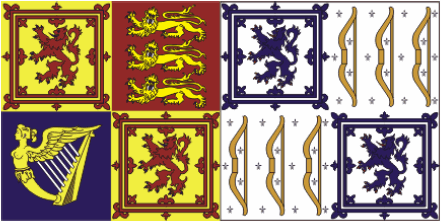 Possible Standard of Queen Elizabeth for use in Scotland
Possible Standard of Queen Elizabeth for use in ScotlandQueen Elizabeth, the Queen Mother 1953 (?) - 2002.
In Scotland Queen Elizabeth, the Queen Mother, may have use this version of her Standard with "the Royal Standard for use in Scotland" in the hoist, but this is not certain.
 Standard of Princess Elizabeth
Standard of Princess Elizabeth
[Royal Standard differenced by a three point label charged with one Tudor rose and two crosses of St George]Princess Elizabeth 1948 (?) - 1952
Princess Elizabeth was the elder daughter of King George VI, and later became Queen Elizabeth II when she succeed her father upon his death.
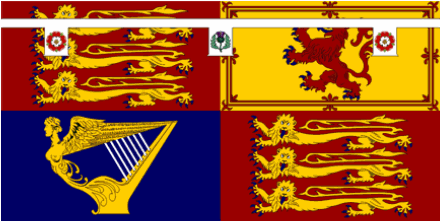 Standard of Princess Margaret
Standard of Princess Margaret
[Royal Standard differenced by three point label charged with one thistle and two Tudor roses]Princess Margaret 1948 (?) - 2002
Princess Margaret was the younger daughter of King George VI. This Standard and the impaled Standard of Queen Elizabeth, the Queen Mother, were the only personal Standards that included the Royal Standard when the Royal Standard was revised in 1956-57. It was pointed out at the time, by both the Lord Chamberlain's Office and the College of Arms, that personal Standards based upon the Royal Standard should not be altered to conform to alterations in the Royal Standard without the consent of the owner of the personal Standard.
 Standard of Phillip, Duke of Edinburgh 1951-1952
Standard of Phillip, Duke of Edinburgh 1951-1952
[Quartered Arms of the Duke of Edinburgh and Arms of Princess Elizabeth, impaled.]Phillip Mountbatten, Duke of Edinburgh, Consort of Princess Elizabeth 1951 -
Phillip Mountbatten, often referred to as "Prince Phillip," is husband to Queen Elizabeth II. His standard is three blue lions and nine red hearts on yellow for Denmark, a white cross on blue for Greece, two vertical black stripes on white for Mountbatten and a black castle on white for Edinburgh. The design of the Standard was approved by King George VI in November 1951.
Since the time that Princess Elizabeth became Her Majesty Queen Elizabeth II, the Duke has only used the plain family Arms as his Standard.
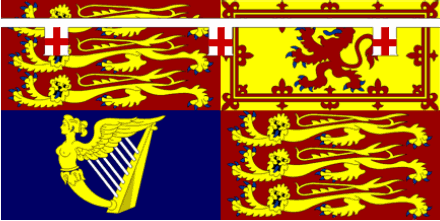 Standard of Princess Mary
Standard of Princess Mary
[Royal Standard differenced by three point label charged with three crosses of St George]Princess Mary 1957 (?) - 1965
Princess Mary was the only daughter of King George V. The eldest daughter of the Sovereign is usually, but not automatically, granted the title "Princess Royal." Her Royal Highness, Princess Mary, became "Her Royal Highness, The Princess Royal," in 1932, but seems not to have been granted a Standard of her Arms until about 1957. Her label is not shown in Campbell & Evans' "Book of Flags" until the 1957 edition, and, as was noted above, the Standards of Queen Elizabeth, the Queen Mother, and Princess Margaret were said to be the only existing personal Standards that included the Royal Standard when the design of the Royal Standard was revised in 1956-57. There is no definitive Standard for the Princess Royal as the charges on the label are the same as the charges on the Arms of its owner. Thus the charges on the Standard of the present Princess Royal (Princess Anne) are one heart and two crosses of St George.
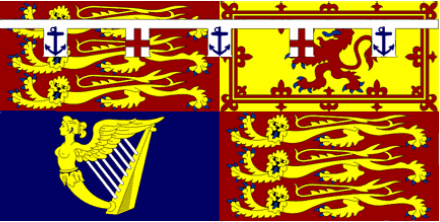 Standard of Edward, Duke of Kent
Standard of Edward, Duke of Kent
[Royal Standard differenced by a five point label charged with two crosses of St George and three blue anchors]Edward, Duke of Kent 1957 -
Edward, the current Duke of Kent, is the son of the late George, Duke of Kent, who was the fourth son of King George V.
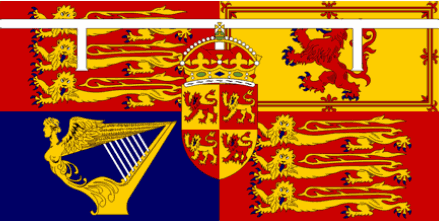 Standard of Charles, Prince of Wales
Standard of Charles, Prince of WalesCharles, Prince of Wales 1958 -
Prince Charles is the eldest son of Queen Elizabeth II. Charles was granted the title Prince of Wales in 1958. His Standard is the same as the 1911 Standard of the Prince of Wales, except for the changes made to the basic Royal Standard in the intervening period.
 Standard of Princess Alexandra
Standard of Princess Alexandra
[Royal Standard differenced by a five point label charged with one cross of St George, two blue anchors and two red hearts]Princess Alexandra
Princess Alexandra is the only daughter of the late George, Duke of Kent, fourth son of King George V.
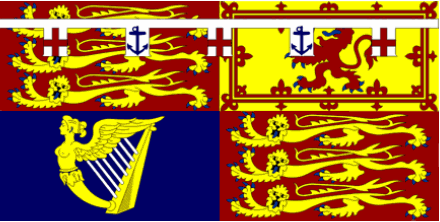 Standard of Prince Michael of Kent
Standard of Prince Michael of Kent
[Royal Standard differenced by a five point label charged with three crosses of St George and two blue anchors]Prince Michael of Kent
Prince Michael of Kent is the younger son of the late George, Duke of Kent, fourth son of King George V.
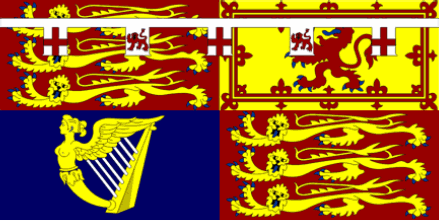 Standard of Richard, Duke of Gloucester
Standard of Richard, Duke of Gloucester
[Royal Standard differenced by a five point label charged with three crosses of St George and two red lions, passant guardant]
Richard, Duke of Gloucester
Duke Richard of Gloucester, is the younger son of the late Henry, Duke of Gloucester, third son of King George V.
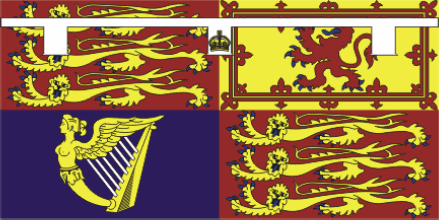 Standard of Edward, Duke of Windsor
Standard of Edward, Duke of Windsor
[Royal Standard differenced by three point label charged with one Royal Crown]Edward, Duke of Windsor 1972
Arms were granted to King Edward VII after he had abdicated and been given the title "Duke of Windsor." Reports of his funeral state that his coffin was covered with his Personal Standard, although in 1969, just three years before his death, it was stated in Campbell & Evansī "Book of Flags" that "he has not yet been granted a flag," which suggests that the Standard may have been created specifically for his funeral.
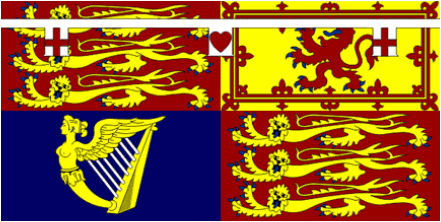 Standard of Princess Anne
Standard of Princess Anne
[Royal Standard differenced by three point label charged with one red heart
and two crosses of St George]Princess Anne 1975 (?) -
Princess Anne is the only daughter of Queen Elizabeth II. She was granted the title "Princess Royal" in 1987. A version has the same label on "the Royal Standard for use in Scotland."
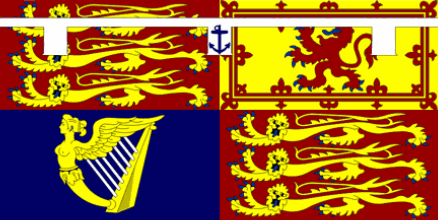 Standard of Andrew, Duke of York
Standard of Andrew, Duke of York
[Royal Standard differenced by three point label charged with one blue anchor]Andrew, Duke of York 1986 (?) -
Andrew, Duke of York, is the second son of Queen Elizabeth II. His standard is the same as that of his grandfather, who became King George VI. A version has the same label on "the Royal Standard for use in Scotland."
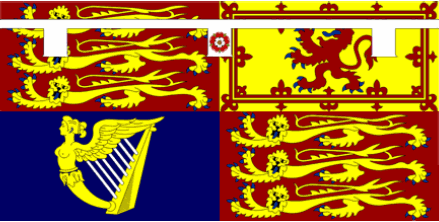 Standard of Edward, Earl of Wessex
Standard of Edward, Earl of Wessex
[Royal Standard differenced by three point label charged with one Tudor rose]Edward, Earl of Wessex 1999 (?) -
Edward, Earl of Wessex is the youngest son of Queen Elizabeth II. The title "Earl of Wessex"" had not previously been used for nine hundred years, and when created it was announced that "His Royal Highness will be given the title Duke of Edinburgh in due course, when the present title now held by Prince Philip eventually reverts to the Crown." A version has the same label on "the Royal Standard for use in Scotland."
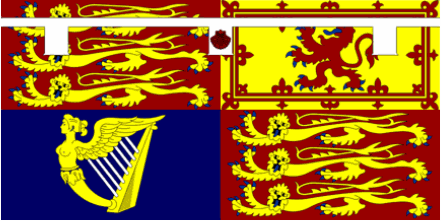 Standard of Prince William of Wales
Standard of Prince William of Wales
[Royal Standard differenced by a three point label charged with one red scallop]Prince William of Wales
Prince William of Wales is the elder son of Charles, The Prince of Wales. The scallop is a reference to a charge on the Arms of his late mother, Lady Diana Spencer, The Princess of Wales.
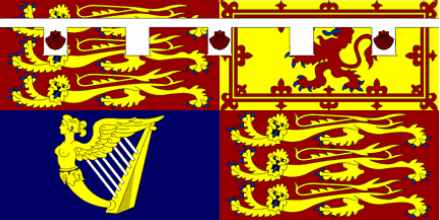 Standard of Prince Henry of Wales
Standard of Prince Henry of Wales
[Royal Standard differenced by a five point label charged with three red scallops]Prince Henry of Wales
Prince Henry of Wales is the younger son of The Prince of Wales.
The illustrations are by Martin Grieve from the following sources:
- Royal Standard in the 19th century. Flags and Signals of All Nations, Hounsell Brothers, 1873.
- Royal Standard after 1907: Admiralty, Drawings of the Flags in use etc., 1907.
- Royal Standard 1957:Flags of the World, Gresham Carr, 1961.
- Prince Albert. Album des pavillons etc., M. A. Le Gras, 1858.
- Alfred, Duke of Edinburgh. Flags and Signals of All Nations, Hounsell Brothers, 1873.
- Edward, Prince of Wales. Flags and Signals of All Nations, Hounsell Brothers, 1873.
- Duke of Connaught, with Saxony escutcheon. Lloyd's Book of House Flags and Funnels, 1912.
- Prince of Connaught, with Saxony escutcheon. Assumed to be similar to his father's Standard.
- Queen Alexandra: Prince of Wales with Welsh escutcheon. 1913 amendment to 1905 Flaggenbuch.
- Queen Mary. Flaggenbuch 1926.
- Albert, Duke of York. Flaggenbuch 1926.
- Henry, Duke of Gloucester. Admiralty BR 20, volume II, 1958. George, Duke of Kent. Flaggenbuch 1939.
- Queen Elizabeth, Queen Mother: Book of Flags, Campbell & Evans 1953.
- Princess Elizabeth. Flags of the World, H.Gresham Carr, 1953. Princess Margaret. Admiralty BR 20, volume II, 1958.
- Princess Mary. Admiralty BR 20, volume II, 1958.
and,
- Edward, Duke of Kent.
Princess Alexandra.
Prince Michael of Kent.
Richard, Duke of Gloucester.
Princess Anne.
Andrew, Duke of York.
Edward, Earl of Wessex.
Prince William of Wales.
Prince Henry of Wales.
All from British Flags & Emblems by Graham Bartram.